William Kentridge, still from Self-Portrait as a Coffee Pot, Episode 1: A Natural History of the Studio (2022) Courtesy William Kentridge Studio
At the height of the Covid-19 lockdowns in 2020, people all over the world were stuck by themselves (and with themselves), thinking over hard existential questions. Inside his Johannesburg studio, the South African artist William Kentridge took it a step further—making a film series in which two versions of Kentridge discuss philosophical topics and argue with each other about misremembered childhood occurrences. At times, a third Kentridge drops in to play peacemaker or explain something to the camera.
Made over the span of two years and now streaming on Mubi, the nine-episode Self-Portrait as a Coffee Pot (2022) combines humour and seriousness through dialogue (and monologue), animation, drawing, music and performance. A Dada-esque love letter to the studio and art-making, the series is delightfully optimistic. It is also exactly what one might expect from Kentridge in lockdown.
Kentridge has described Self-Portrait as “intended as a polemic experience about a way of working, a confidence in giving an image the benefit of the doubt, and seeing what emerges”. With each 30-minute episode, the artist takes the audience through his sometimes convoluted process of art-making—from charcoal drawings to ripped and reconstructed pieces of paper, giant shadow puppets and wall projections—all while using his signature drawing-and-erasing stop-motion animation style. Drawings morph and transform on the studio walls as Kentridge walks around thinking (“productive procrastination”, he calls it), always wearing his familiar uniform of a white dress shirt and black trousers.
At night, while Kentridge is presumably sleeping, mice made of crumpled paper scurry along his desk and play the piano, as an old tuba dances with an equally ancient video camera. Even during the day, there is dancing throughout the series—Kentridge dancing with an animated drawing of a skeleton or with his other self, visiting dancers whom the artist invites to his studio in later episodes (as the pandemic eases a bit).
William Kentridge, still from Self-Portrait as a Coffee Pot, Episode 2: Self-Portrait as a Coffee Pot (2022) Courtesy William Kentridge Studio
As ever with Kentridge, music also plays a large role. Part of an episode is devoted to the Russian composer Dmitri Shostakovich (Kentridge staged his opera The Nose for New York’s Metropolitan Opera in 2010). And at the end of the series, when all of the Kentridges, studio assistants and invited actors, dancers and performers are shown leaving the confines of the studio for the first time, it is a marching band that leads them out into the street.
While the mood of Self-Portrait is generally upbeat, the shadow of Covid looms, with records of the number of deaths in Johannesburg fleeting across the screen along with long lists of studio assistants who have recently tested positive. Kentridge draws trees and leaves, comparing their lives to those of humans. “As we are growing, so too we are growing our own death,” he says, contemplating the unknown fates of individuals.
One of the two main Kentridge characters acts as a pessimist to the other’s optimism, playing out what sometimes reads as a hilarious sibling rivalry and at others as acting out the duality of man. As the two Kentridges discuss Greek mythology, the history of mining in Johannesburg, colonialism in Africa and the absurdity of the Soviet Union, they delve into many of the more serious topics familiar in much of the artist’s work.
While exploring the “paradoxes of colonialism”, Kentridge invites several actors to read from his performance piece The Head & The Load. Later they interpret, in stilted movements, a contradictory situation in which an African soldier forced to fight alongside the French during the First World War might aspire to become a citizen of the very country that brutally colonised his people.
Kentridge’s Dadaist inspirations come to the fore during the episodes devoted to history, but his “investigations into coherence and incoherence” take place throughout the series—and it is never clear what the titular coffee pot has to do any of it. “That which comes after always changes that which is prior,” says Kentridge as a kind of conclusion during the last episode. And in as much as Self-Portrait is a celebration of the creative process—Kentridge lovingly calls the studio both “a place of transformation” and “a safe space for stupidity”—it is also an exploration of the experience of time and space. In that sense, it doubles as a creative time capsule of the experience of a Covid lockdown.

